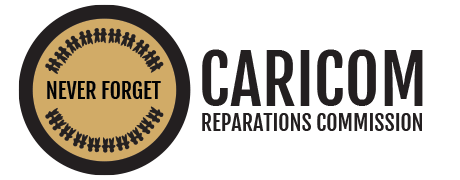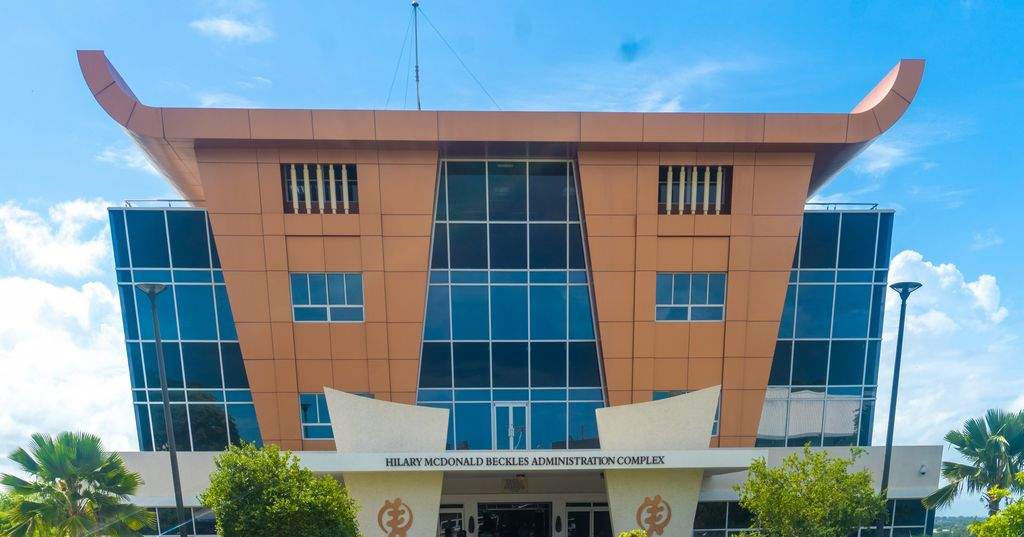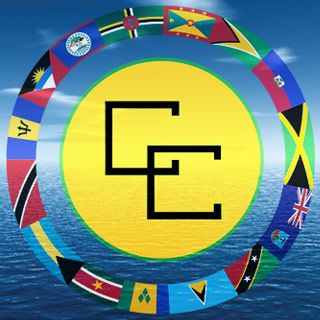A clear illustration of a Caribbean luminary’s view of the Art and Science of Decolonization and Nation-building in the Age of Reparations.
By Earl Bousquet
When I attended my first meeting of the CARICOM Reparations Commission (CRC) at the Cave Hill Campus of The University of the West Indies (The UWI) in Barbados in 2014, I left with some indelible impressions, the two longest-lasting being my first encounter with the types of various illustrative presentations by CRC Chairman Sir Hilary Beckles and the story behind the building we were meeting in.
Sir Hilary was the Principal at Cave Hill at the time and his explanations of the history behind the unique ‘African stool’ shape of the campus’ main administrative building opened more than just a few new windows on the philosophies that shaped African architecture.
The Golden Stool
The building had been loosely but progressively sketched countless-times-over on paper by Sir Hilary and engineers and architects helped give life to his ideas in a way that would reflect the best illustrative example of the appropriateness of African architecture in the Caribbean.
The four-level structure, shaped like a stool, was conceptualized to reflect the architectural motif of the Golden Stool of the Ashanti that serves as a symbol of cultural identity and a collective wisdom of elders and ancestors.
The foundation plaque was indeed laid by the Asantehene (King) of the Ashanti Otumfo Osei Tatu II of Ghana and doors to the magnificent structure formally opened in 2010.
But the iconic building was only one of several Sir Hilary crafted for the campus and delivered during his 13 years as Principal, including: the Errol Barrow Centre for Creative Imagination, the China-India building (that hosts the Confucius Institute) reflecting the region’s Asian heritage and the CLICO and SAGICOR buildings (with majestic pillars) reflecting the region’s European legacy, the Usain Bolt Sport Complex and the 3Ws Oval – the last two celebrating the legacy of the world’s fastest man and three of the best West indies cricketers ever.
Simply Remarkable
That it was the first architectural design of its kind to be erected on this side of Africa was (and still is) simply remarkable.
But even more so was that this African stool sits and stands in a region dominated by descendants of African slaves, in the country that established the first African slave society in the world and represents the premiere educational institution on the island and of the Caribbean.
Its story of the Golden Stool was (and still is) itself part of the continuing African legacy in the Caribbean.
It came with the largely increased awareness of the real history of the continuing Afro-Caribbean link beyond slavery and the unique drive by one set of governments to engage another across the table in talks about apology and atonement through Reparations for Slavery and Nat8ive Genocide.
Living the past better…
It was like living the past today, better than ever. At the recalled meeting six years ago, Chairpersons of National Reparations Committees (NRCs) had gathered in the best possible location of a premier regional entity to discuss the premier task of pursuing this historic duty at a time and in a manner that was (and still is) both unprecedented and with the best possibilities for long-elusive success.
The CARICOM leaders were counting on the CRC to advise appropriately on how best to pursue Reparations from London and Brussels and the first task was to write the UK and EU heads of government, collectively and individually, requesting a forum to discuss an approach to the CARICOM request for apology, atonement and reparations for the genocidal slaughter of the region’s First people and the TransAtlantic Slave Trade.
This move was (and still is) unprecedented as it involved a group of 14 member-states of the united Nations (UN) collectively demanding reparations for the criminal excesses of European nations in this part of the world after Columbus’ arrival in 1492.
The African continent, as represented in the African Union (AU) today, from where tens of millions of African slaves were kidnapped, shipped and sold into slavery in the British, French and Dutch West Indies or Antilles and the Americas, had (and still have) not taken any similar decision to collectively pursue reparations from Europe.
At the time (and up to now) only Kenya had successfully extracted reparations from Britain by way of payments to victims of the Mau-Mau Massacre by British troops during the independence fight in the mid-60s.
Namibia was also then considering how to make similar claims against Germany for genocide against hundreds of thousands of tribespeople at the beginning of the 20th century.
African states from which slaves were exported to the Caribbean and The Americas have largely exhibited historical locations associated with slavery as tourist sites, while ignoring the necessity to revisit and revive the historical ties that led to a community of nations of descendants of the same African slaves who left their shores and have since survived sustained European economic and social decimation and dehumanization.
There we were in largely more than just ceremonial African garb, gathered at the only building of African architecture of its size and kind in the Caribbean, refreshing our lessons on historical links with the continent and hoping to eventually attract the support of Africa in our noble quest for reparations.
Common Denominator
Visiting all those structures at meal times between meetings, the non-Barbadian Caribbean delegates were as impressed with what they represented as with the common denominator underlining them all: Sir Hilary.
Current Cave Hill Principal Eudine Barriteau said her predecessor merited the honor (of the building being named after him) for a multitude of reasons including his 40 years of service to The UWI, his leadership of the university’s fight against the COVID-19 Pandemic, while hailing his advocacy work in ‘social justice and minority economic enfranchisement’, concluding that ‘he is someone who thinks ahead of the times and his emphasis on reparatory justice is one example.’
Under his watch (2002 to 2015) and as the youngest professor appointed to lead Cave Hill, Beckles widened its property range and tripled enrollment from 3,000 to 9,000.
Uncompromising in his exposure of historical facts and figures that explain and reveal the hitherto hidden truths behind the British role in TransAtlantic Slavery, but characteristically humble if asked about himself, Sir Hilary swallowed a mouthful of water when asked by a reporter to respond to his latest crown of deserved laurels.
He humbly replied: ‘My entire professional life has been dedicated to perfecting a contribution to the within the context of institutional and public education.’
He insisted, however, that this latest acclamation of his continuing contributions ought to be shared with his colleagues at various levels across The UWI community, without whose shared efforts none would have been possible.
Fertile Imagination
But even his critics will admit that none of it would not have been possible without the incomparable level and fertility of Sir Hilary’s creative imagination.
During a luncheon discussion with Sir Hilary and the illustrious and indefatigable George Lamming at the 3Ws Oval, I took my own imaginary flight viewing the location from aloft in a helicopter (drone technology wasn’t yet what it is today) I saw what I wished: a replay of one of those cricket matches between the West Indies and England that made the Caribbean players the pride of the region and the indisputable Kings of World cricket in the 1960s, 70s and 80s – like the match during which Gary Sobers set a world record after easily lobbing an English bowler for six sixes in one over.
I looked down on a rearrangement of the Golden African Stool, the Confucius Statue and the European Pillars, relocated around the perimeter of the Three Ws Oval and filled to capacity with a mix-up of Caribbean and African, European, Indian and Chinese Caribbean citizens all rooting for the Windies team, while beating drums and blowing horns in common celebration with the large team of rowdy ‘Barmy Army’ England supporters and their Bajan backers decked in Union Jack couture.
Back to Life…
I was soon brought back to the table by Lamming, who simply called my name to see whether I was awake…
Lamming did not look anything like being about to cap his pen.
I’d met him previously in Grenada during the Revolution and in the company of our mutual friend and veteran Caribbean journalist Rickey Singh and our friendships taught me, over time, to better understand, as a journalist, just how much ‘Silence is Golden’ — and we learn more when we listen – and we hear nothing when we are talking.
I saw that same creativity in the fertility of Sir Hilary’s imagination and thereafter recommended to friends with interest in architecture to visit The Golden Stool at Cave Hill.
One young home-grown colleague Googled the campus and saw a photo of the building and said he was ‘impressed’. Then, several months later after taking a break during a meeting on assignment with the Caribbean Development Bank (CDB) in Bridgetown to visit and photograph it, he sent me a WhatsApp message saying: ‘Wow! I am really, really impressed!’
Fast Forward…
Fast Forward ten years after The Golden Stool’s unveiling…
Sir Hilary vacated his lofty position at Cave Hill on year after our meeting (2015) after 13 years as principal to assume his current post as Vice Chancellor of The UWI; and five years later the Cave Hill administration decided to name the building after him.
With the benefit of hindsight and retrospect, in my mind, the giant African stool at Cave Hill went (and still goes) a very long way in infusing that level of consciousness of their African connection among Barbadian and Caribbean students gracing its walls, maintaining the university’s traditional reputation as a proud producer of the region’s best brains and minds over the past seven decades.
Caribbean History, as currently being taught in constantly renewed and upgraded school texts and revised studies, has also produced better understanding of the need to continue to correctly rewrite our story, as against ‘his story’ told and taught by European historians over centuries.
Today, more Barbadians support removal and relocation of Nelson’s Statue; and the majority of students and faculty supported the change of name of ‘Milner Hall’ at the UWI’s St Augustine Campus in Trinidad & Tobago because of its historical association with Cecil Rhodes, the founding father of Apartheid in Zimbabwe, which had been renamed ‘Rhodesia’ after him.
Resurgence of popular consciousness
Today, thanks to the resurgence of progressive and popular Caribbean political consciousness over the past nearly 37 years since implosion of the Grenada Revolution, Caribbean governments are pursuing a common Reparations agenda, supporting and defending Cuba, opposing US military intervention in Venezuela, incessantly sending students for scholarship studies at the University of Havana and accommodating Cuban doctors and nurses in every CARICOM member-state.
At the same time, Caribbean people are more prepared to mobilize (or be mobilized) against blatant violations of human rights and clear injustice, more willing to back just causes at home and abroad as shown in their support for clear manifestations of human rights violations and in the recent responses across the region to the Black Lives Matter movements and protests in the USA.
At the same time, students want to learn more about the Caribbean’s true history, teachers are deepening and broadening their teaching and skills — and there’s more interest in the historical roles of Caribbean personalities like Sir Arthur Lewis, the intellectual author of the first Caribbean Blueprint for Reparations (1939).
And the UWI remains, now more than ever, the fountain of Caribbean knowledge, from whence cometh the majority of CARICOM’s leaders at any one point in time.
The UWI’s contribution to the shaping of the Caribbean’s future, as envisaged by the likes of Sir Arthur and other luminaries, is seen playing out today in the sort of ‘Pelican Pride’ being expressed daily by UWI graduates on the university’s increasingly popular television channel UWItv Global, in their current roles as Heads of Government, leaders of regional institutions and individuals professionally contributing to the common goal of Caribbean development.
But Sir Hilary, the Golden Stool and The UWI are not mere dreams, but real facts of life that have impacted (and continue to influence) the course of Caribbean development and the region’s necessary reconnection to the African continent from whence the majority of its people cometh.





